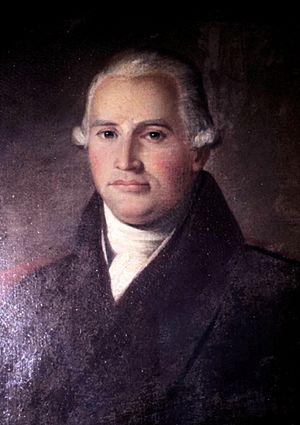Dunbar-Hunter Expedition of 1804-1805 facts for kids
The Dunbar-Hunter Expedition was an important journey that happened in 1804 and 1805. It was led by two explorers, William Dunbar and George Hunter. Their main goal was to explore the southern part of the Louisiana Purchase, which was a huge area of land the United States had just bought.
President Thomas Jefferson asked them to explore parts of what are now Mississippi and Missouri. During their trip, they wrote down a lot of information about the Ouachita River. They also studied the famous hot springs in modern-day Arkansas. The expedition gave us some of the very first descriptions of the lands of Arkansas and Louisiana.
Getting Ready for the Trip
William Dunbar was a scientist from Scotland. He lived in Natchez, Mississippi, when President Jefferson asked him to lead this new expedition. Jefferson wanted the team to travel through the southern lands of the Louisiana Purchase. He especially wanted them to follow rivers like the Red River or the Arkansas River.
George Hunter was the other main leader of the expedition. Jefferson also asked him to join. Hunter was told to "make observations" and "note courses." This meant he should carefully watch and record everything, just like Dunbar. He also had to keep his own separate journal. This way, if their notes were different, they would have both records.
In 1804, a special boat was built for the expedition. It was first planned for them to travel down the Red River. However, their plans changed. They heard that traveling the Red River might cause problems with a group of the Osage tribe living there. So, the new plan was to go to the hot springs instead. With this new goal, the expedition finally set off in October 1804.
The Journey Begins
The expedition team started their journey from a place called St. Catherine's Landing. This spot was right on the Mississippi River. There were about 19 people in the group. This included the main explorers, their assistants, and other helpers.
George Hunter designed the boat they used for the trip. It looked a bit like a flat-bottomed boat called a scow. The team even called it a "Chinese-style vessel."
According to George Hunter's journal, the group traveled along several rivers. They went down the Red River, the Black River, and the Ouachita River. Eventually, they reached the famous hot springs.
As they traveled, the team carefully observed everything around them. They studied the land, the people they met, and the rivers and waters. Once they reached the hot springs, they turned around. They began their journey back to where they started.
William Dunbar left the group early near a place called Fort Miro. He took a land route to go home. He wanted to share the expedition's important findings with the government right away. He did this by sending a copy of his journal. The rest of the team kept going back to St. Catherine's Landing. Their long journey finally ended in January 1805.
Amazing Discoveries
The Hunter-Dunbar Expedition made many important discoveries. They recorded scientific observations and learned about the Native people living in the areas they explored.
At the hot springs in Arkansas, both Hunter and Dunbar made many observations. Hunter studied the quality of the water in the springs. Dunbar worked to figure out how much water flowed out of the springs. The expedition members even discovered tiny living things, called Microorganisms, in the hot springs!
The expedition also created some of the earliest written records in English. These records described the mountains, rivers, and other land features of Arkansas and Louisiana. Hunter and Dunbar also kept detailed notes about the plants and animals. They found these natural wonders around the Ouachita River.
Their records also included details about the people in the region. This included not only the native people but also fur traders, trappers, and other European travelers. They wrote about how these different groups of people interacted. They also described how people used the natural resources around them to live.


